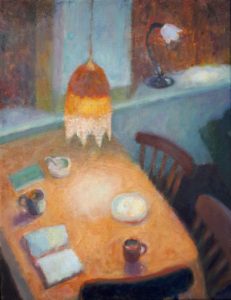
The Chenille Tablecloth by Jo Walter
@jowalter_art
And the memories came to him with a colour and a clarity that was entirely new…
Art in all its forms, is in his blood. For Daniel art is synonymous with love, with the love of parents, or occasionally the apparent lack of it. Mum, a watercolour artist and Dad, a poet. Daniel had become besotted with One Tree Cottage and the art of his uncle, his aunt and his cousins, unique, spontaneous, joyful.
He reflected, Nature is life. We can’t live without the natural world. Naturally, we respond to all that is living around us. We’re as much a part of nature as nature is a part of us.
As human beings we are all essentially creative; sometimes thoughts, feelings, emotions are best expressed through art.
Art, because words can be beautiful too, can carry something of nature, of the moment, can mean something, even as they stand alone. Art because it strikes a chord, resonates a harmony, chimes with the moment and becomes itself.
Crashing through time, he thought of Anthony Gormley,
Daniel had visited an exhibition of Anthony Gormley’s work at the Hayward Gallery: Event Horizon[1]. He was fascinated and in awe: he says so much that is true about the creative experience, and our profound connections with the root of life, Daniel thought. Our connection to the world, to nature, is often more easily accessible through our connection with art, with our true humanity…
The exhibition consisted of life-size figures – casts of the artist’s body – placed on rooftops and walkways both North and South of the Thames. The invasion of these figures spread outwards from The Hayward in all directions, all facing towards the gallery’s three sculpture terraces, from which they could be viewed as a whole. Depending on the weather and time of day, some figures would be clearly visible while others were sensed only as a presence on the horizon.
Daniel, reflected on his experience, when he’d come across an increasingly large number of occasions of serendipity, or synchronicity…
Synchronicity: When two or three event horizons collide, result in a heightened moment, something other than they were each in their own space.
or as Carl Gustav Jung describes, ‘Synchronicity: An acausal connecting principle’
‘You could say that there are two very discrete and almost oppositional places where a sculpture belongs. One is physical: in a landscape or a room, and the other is in the imagination of the viewer, in his/her experience and memory.
‘Sculpture reminds everyone that we are human and that we are embodied, incarnate, that all your sense of self and being comes through the body which is only fully itself when placed, connected to an elemental world.’
Anthony Gormley, 2001.
Rodin
With friends, they visited the Rodin museum on the south bank in Paris several years before, and Daniel was moved to tears by some of the exquisite forms Rodin had created. In contrast to Gormley, Rodin did not try to interpret the universe, but the person, and the person and their love was enough. Daniel, thought of the classics like The Thinker (first entitled The Poet after Dante), The Kiss, Cupid and Psyche, Eternal Spring, and Prometheus Bound.
In so many of his works, Daniel thought, Rodin brought male and female together in the most tender, eternal embrace, and through this reclaims our visceral and spiritual humanity.
Van Gogh
Daniel was convinced that no study of art, nature and mind could be complete without a mention of Van Gogh. Especially those last two years of his life when he had gone mad, which Daniel identified with deeply.
All of these moments came to Daniel in a rush – through umbilical light he saw the whole of art, for what it is, what it means for soul…
[1] Event Horizon comes from cosmological physics and refers to the boundary of the observable universe. Because it is expanding, there are parts of the universe that will never be visible because their light will never reach us…Anthony Gormley, 2007.